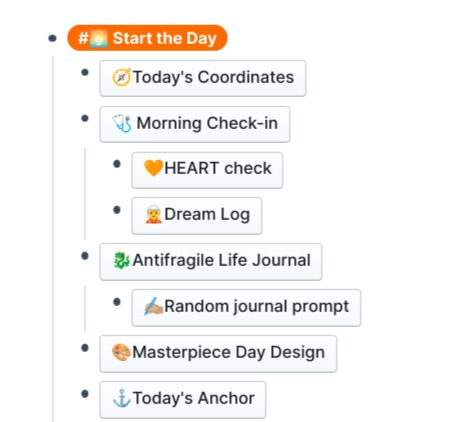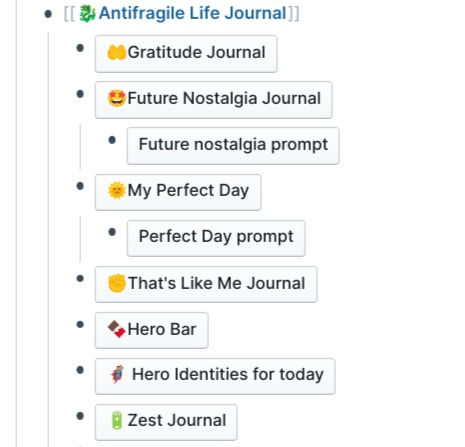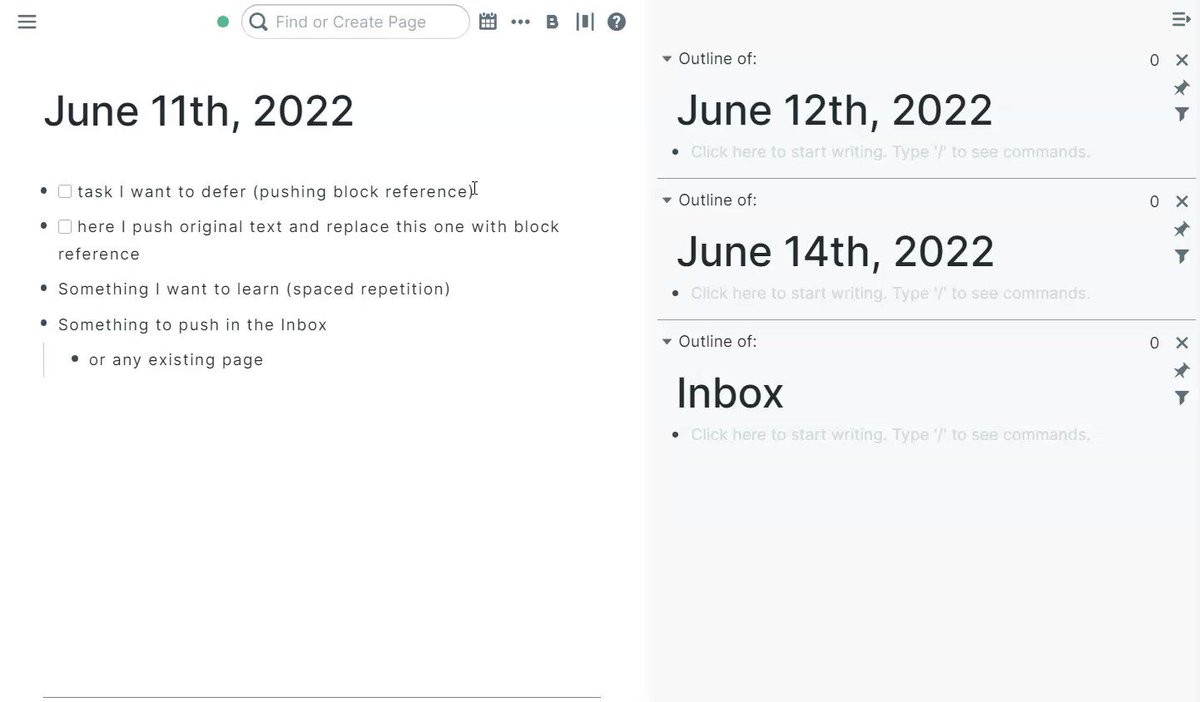[LFR] Letters from a Roaman - Letter XLV & Letter XLVI
Hello again friends,
These Letters are like buses sometimes. You wait ages for one, and then two come along at once! I have to hold my hands up. Letter 45 should have gone out two weeks ago, but “someone” forgot to hit the schedule button. I had a company retreat the following few days, so my mind was elsewhere and I didn’t even think to check in on the newsletter.
While I'm apologising, it also turns out that despite writing 45 letters to date, I still haven’t got to grips with Roman numerals. Jason O’Conal kindly pointed out that I’ve been getting recent numbers wrong. To compound the issue, I managed to confuse myself and think that I was already up to Letter 50 when I tweeted.
I've included the essay which was destined for the previous letter in this one, so it's an extremely long email. Normal service will be resumed next time!
Around the Roaman Empire
Roam Depot
Some big news from the Roam team. Sometime this week, we can expect to find the long-awaited Roam Depot show up. This will enable far easier access for all users installing extensions which have been vetted for security by Roam Research. Developers will be able to charge users, and Roam will also be sharing a percentage of their revenue with developers who maintain plugins. This is a really good move to help foster the long-term availability of plugins, especially those which are free. Too often, plugins that users come to rely on get left to rot when developers have no incentive to continue to spend their precious time maintaining them.
For the developers amongst you, you can submit your extensions via Github and get any help from the Roam team via the #developers channel in the Roam slack workspace.
How to port roam/js extensions for Roam Depot
Josh Brown recorded a Loom video with Abhay, walking through the changes needed to work with the new Roam Depot.
Meta Templates
Check out Chiel’s short thread about his use of Roam’s buttons as meta templates.
Amazing what you can do with Meta templates in Roam.
This is what my morning set-up looks like now, each block is a button which unfolds a new template.
Easy way to incorporate the lessons from @_Brian_Johnson's Optimize course into my Roam setup.
@Conaw pic.twitter.com/s8SGqnZ3Vp twitter.com/ChielMuur/stat…
Heard a lot of people say Notion is so intuitive.
Heard few people say the same about Roam.
But for me, Roam just clicked, and Notion somehow never did.
Love constantly tinkering with my templates.
That Roam is completely fresh out of the box, for me is perfect.
July 5th 2022
|
This is a great concrete example of the use of the Roam template buttons I described in Letter XXII. I really like the checklist-like nature to his morning startup routine, and the emoji flourishes. I’m also intrigued by his use of the buttons to choose the emotions that described his day.
RoamJS PSA
First, some important news for users of RoamJS SmartBlocks. You will likely have seen warnings showing up recently that certain commands will be going away. This is part of the drive towards pushing functions which are better served via true Roam extensions, which can be delivered via Roam Depot, ensuring that the code is vetted before being let loose in your graph data.
RoamJS Multiplayer is also now completely free to use. Previously you needed to pay a subscription fee to use asynchronous mode.
There have been several handy updates to the Query Builder extension too.
You can now do some simple calculations of values from other derived columns. “Edited by” and “Is Referenced By” have been added as new conditional operations, which is great news for shared graphs. It makes it easier to create notifications-style interfaces for graph users to keep up to date with everything that’s going on.
Last call for AP Productivity Cohort 5
Today is pretty much your last chance saloon to join cohort 5 of RJs popular AP Productivity course. It’s already started, but you can join until Wednesday.
RJ is also offering a slightly cut-down, self-paced video course version called AP Productivity: Essentials though you do get access to RJ through regular office hours.
Watch this space
Roam Book Club will return. I’ve had quite a few people ask me if Roam Book Club is dead. That couldn't be further from the truth; the core team have been running some smaller-scale experiments and working away quietly behind the scenes as we try to take all that we have learned to deliver ever better book clubs in the future. We want to make it easier for anyone to start and run their own book clubs using Roam.
I can’t reveal too much right now, but we are hard at work planning and preparing for the next round, which will begin in early September. We’ll have more details and information to share in the coming weeks.
Inside Ali Abdaal’s Second Brain
Tiago Forte interviews Ali Abdaal, exploring how he uses Tiago’s CODE concept to manage his world, which features Roam for several aspects.
Build your own self-awareness system in Roam
My favourite journaler, Tracy Winchell, recorded a short Loom giving a peek into her implementation of RJ’s AP Productivity system and going into more detail about how she wrapped it with her self-awareness journaling practices.
It contains some great ideas if your journaling practices are in need of a refresh or reboot.
Inventing your own note-taking language
Norman Chella (of RoamFM) noodles with his ideas around inventing your own note-taking language.
Roam is Local First
A more tech-oriented topic, but Niki Tonsky’s 10-minute talk is a good introduction to how Roam itself is architected as local first.
Conor’s thread which mentioned the video is also an interesting read.
Push Blocks
Another Smartblock, available from the SmartBlock store, from Fabrice Gallet to push blocks to future daily notes and use as spaced repetition.
Check the short demo video in his tweet.
June 11th 2022
|
PhoneToNote SmartBlocks Integration
Phonetonote now integrates with Smartblocks so your captured notes can directly fire off a SmartBlock when the note is added to your graph.
As a reader of LFR, Scott has kindly agreed you’ll get 25% off for up to 12 months if you sign up for PhonetoNote and use coupon code ANDY25.
Thinking Out Loud
Originally, for Letter XLV (45) I had planned to write a single short essay around data ownership, but as I wrote, it grew longer and longer, and since I’m trying to keep these newsletters to a shorter length, I chose to break it down into multiple parts, which I’ll send out over the coming letters. As with all my essays, they are my way of learning in public, so if you have thoughts or feedback, I’d love to hear them. Just reply to this email.
In this series of essays, I aim to explore the true cost of full control of your notes so you can better evaluate what’s most important to you and ensure that you choose the tool best suited for your use-cases and which also matches your stance on control.
Coming to terms
Two key terms are worth defining as they are often conflated; data ownership and data security.
When people talk about data ownership, generally, they’re talking about “vendor lock-in”, where they are stuck with a tool they no longer want to use but can’t leave because they rely on needing access to the information, and the tool is the only one that supports the format.
Data security is more closely concerned with data privacy and the ability to control access to your data.
There is also a third term that few seem to use that is typically lumped in with data ownership: data availability. Here, we’re talking about ensuring the information you need is available when you need it. Most often, this is described in terms of syncing capabilities, i.e. what if Roam goes down or goes away? Actually, it is more closely aligned with data security and privacy by virtue of making sure that the notes on your computing devices are appropriately protected against theft and loss.
To own your notes fully means that you must become completely responsible for their security and availability over their lifetime.
Of these three definitions, I suggest that data ownership is the least important component and that the true answer lies, for the most part, in personal preference, depending on where you stand between idealist and pragmatist.
Throughout the next few Thinking Out Loud letters, we’ll dig into these definitions in more detail to decide where we must draw the line for ourselves.
Vendor lock-in
This is usually what people think they mean when they say they want full control of their notes, but as you’ll see later, there are plenty of other issues that you must consider in the total cost of ownership equation.
Vendor lock-in is a legitimate concern, but as with everything, there is a line to tread. No one wants to be stuck with a tool that they no longer want to use, or that is no longer supported.
Typically the lock-in is due to proprietary data formats or a lack of data export capability.
Now the question is, what is a proprietary format? Wikipedia defines it as “a file format of a company, organisation, or individual that contains data that is ordered and stored according to a particular encoding-scheme, designed by the company or organisation to be secret, such that the decoding and interpretation of this stored data is easily accomplished only with particular software or hardware that the company itself has developed.”
Certainly, for Roam, this isn’t the case, though the line can feel a bit blurry because of Roam’s design. It uses an in-memory database in the browser/application to store the data and sync with their servers to make the UI snappy for both single-user and multi-user collaboration–since, ultimately, that’s Roam’s purpose. From day one, Roam could export its data as Markdown, JSON, and, more latterly, EDN.
Data formats
EDN (Extensible Data Notation) is a lossless format for Roam data. Ostensibly this is their file format. It’s not proprietary, but it’s not simple to take and use to open your data in other tools.
This is the inherent tension in the use of these so-called tools for thought right now. Roam deliberately chose not to use plain text files as a base file format to realise their vision and open up new ways to structure thoughts; they believe it’s necessary to move beyond files and keep the data in a database. EDN is the database snapshot, enabling you to restore the system’s state back to that point in time.
The risk with Roam and other tools which rely on a database for storing data over individual files is that of full access should they disappear.
This is where open-source software can be an advantage. Having the source code available means it’s possible for someone to continue developing the software, or work out how to transform the data into another format.
On the flip side, with the common expectation that open source software is free, often written by people in their spare time, it is harder for anyone to make a living supporting it. So unless it gets a lot of traction, with many volunteers, it is more likely to die a slow death through neglect.
One option, not often exercised, for closed source software, like Roam or Obsidian, is to have the code put in escrow so that in the event of the company going out of business, it will be released to certain parties to ensure continuity.
Interoperability
Yes, we all want tools that can interoperate on the same data. Still, competition is also desirable to drive innovation, which often means that any standards take time to conceive and evolve through practical use.
That is certainly the case in the tools for thought space right now. We are in the very earliest days and do not yet know how it will evolve for the best.
By settling on a publishing format like Markdown early as the defacto “interoperable” standard, we may inadvertently find that while a large part of our basic notes are accessible, relying on plugins that come and go may cause the plain text notes to become more brittle if they cannot sensibly store information in a readable plain text representation.
Markdown as a faux standard may lull you into a false sense of security where application-specific extensions do things differently. For example, Obsidian and LogSeq both operate using Markdown as the underlying shared data format, but they each handle and represent block references differently.
Representing the fundamental data structures that Roam uses in a more open and structured interchange format like JSON or EDN makes it easier to move to new tools with more note fidelity since there’s a stricter data structure which can help to transform the data more accurately. Indeed there are already several converters available to take Roam’s JSON into other tools.
Ultimately the concern and your choice boil down to perceived interoperability and credible exits.
Exporting data is necessarily lossy to varying degrees. Passing files around introduces a time lag that, unless you guarantee you are the only person who will be using the file and the data it contains in its entirety, then you cannot use it effectively without dealing with data conflicts.
To deal with interoperability with database-style storage, APIs are a more effective mechanism to exchange data with other tools, but this requires more standards and eco-systems to thrive and reduce the risk of a single tool.
Not all notes are created equal, and their inherent value to you changes over time. Most will reduce; they were more for thinking or clarifying something in the moment. From a longer-term perspective, the valuable notes are the well-thought-out or project artefacts, or as is starting to become clearer to me, the interlinked relationships between notes over time. These notes are what I care about ensuring high fidelity in the future.
There is no absolute right answer, only personal choice once you weigh the pros and cons and look at what you’re using the tools for and what matters most to you in the future. Then you can take the appropriate actions to protect that data suitably. We’ll look more deeply into data security and privacy in part two.
Thanks for reading. And don't forget you can give me your feedback by replying to this email. I read and appreciate them all, even if I cannot respond to everything.
Until next time,
Andy
P.S. If you enjoy my work and find value in the ideas I share, please consider contributing to my running costs. I accept donations via Buy Me a Coffee.
Alternatively, if you'd like some help or guidance for making the most of Roam in your note-taking practice, I offer a few private 1-1 Roam coaching sessions.
Andy Henson
I write Letters from a Roaman, curating community news and resources primarily around Roam Research, though I also include other information applicable to other tools for thought and the area in general. I also share my thoughts on a wide variety of tools for thought topics.
Hello Reader, Last week, we talked about Decision Time, the surprisingly effective technique for helping you to get started planning your important tasks and projects. If you did, and you still sat there frozen like a deer in headlights, as promised, here's another little technique that Alan Lakein has up his sleeve that you can try if you're still finding yourself blocked by all the constraints and problems you're facing. This technique is a great psychological way to hack your brain when...
Hello Reader, What do you do when you sit down to plan something out? If you’re anything like me from 5 years or so ago, perhaps it looks something like this: I sit down, pen and paper in hand, and computer at the ready. I get myself a fresh coffee and start thinking about the project or goal I need to work on. I stare into space and ponder the sorts of things that could be done. After about 5 minutes or so of staring, one of two things would happen. 1.I decide I don’t have enough...
Hello Reader, According to Max Lugavere, author of Genius Foods, sitting for an extended period will literally cause blood to drain from your brain, which can impair your cognitive function. As I've touched on over the last few emails, I highlighted the danger of us being active and sedentary. Active movement throughout the day is better for our health and well-being than only exercising once for 30 minutes and then generally sitting still for the rest of the day. Let's wrap up our discussion...




